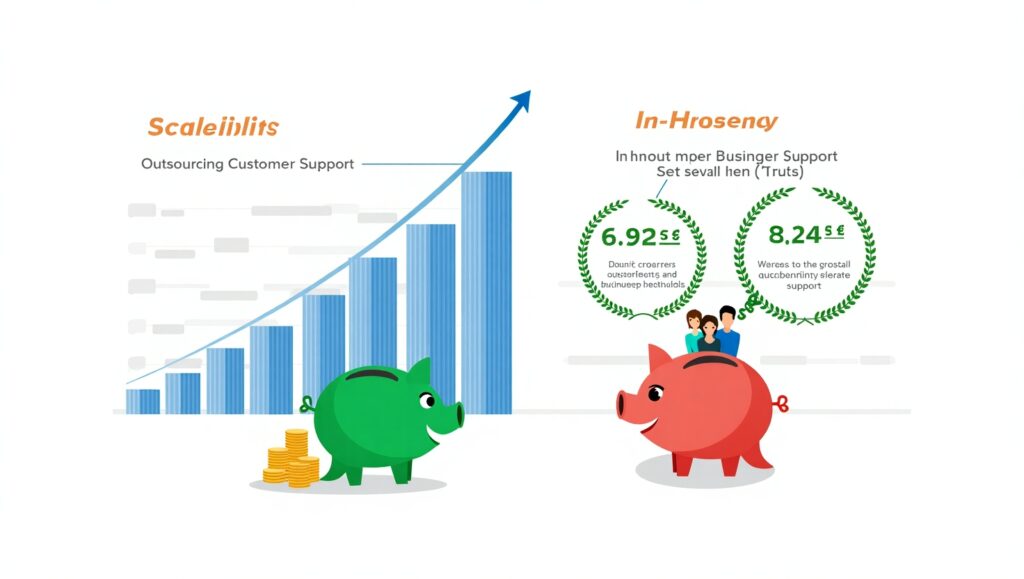What Is Customer Support Outsourcing?
In today’s fast-paced business landscape, delivering exceptional customer service is no longer just a nicety; it’s a necessity. Companies across various industries are constantly seeking ways to enhance their customer support operations without breaking the bank. One strategy that has gained significant traction is outsourcing customer support. But what exactly does this entail?
Customer support outsourcing involves partnering with external providers to manage all or part of your customer service operations. This can range from call center outsourcing to email support services, and even live chat and social media management. By leveraging specialized expertise and technology, businesses can ensure that their customers receive top-notch service around the clock, often at a lower cost than maintaining an in-house team.
For instance, multilingual customer support is a common challenge for businesses expanding globally. Outsourcing allows companies to offer 24/7 multilingual support without the need to hire and train a diverse team of in-house agents. This not only enhances customer satisfaction but also helps businesses scale more efficiently during peak seasons or periods of rapid growth.
Whether you’re a small business looking to streamline operations or a large enterprise aiming to improve customer satisfaction (CSAT) scores, outsourcing customer support can be a game-changer. It offers the flexibility to scale up or down as needed, ensuring that your business remains agile and responsive to changing customer needs.
Why Businesses Outsource Customer Support
As businesses grow and evolve, so do their customer service needs. Outsourcing customer support has become a strategic decision for many companies seeking to enhance their operations while maintaining a competitive edge. But what drives this trend? Let’s explore the key reasons why businesses choose to outsource their customer support.
Cost Efficiency and Scalability
One of the most compelling reasons to outsource customer support is cost efficiency. Building and maintaining an in-house customer service team can be expensive, especially when considering recruitment, training, and infrastructure costs. By outsourcing, businesses can avoid these upfront investments and instead opt for a pay-per-service model that scales with their needs. This flexibility is particularly beneficial for seasonal businesses or those experiencing rapid growth, as it allows them to quickly adjust their support capacity without the long-term commitments associated with hiring new staff.

Access to Specialized Expertise and Technology
Outsourcing providers often have access to specialized expertise and advanced technology that might be difficult for smaller businesses to afford on their own. This includes AI-powered tools for automating routine queries, CRM systems for streamlined customer data management, and multilingual support capabilities that cater to global audiences. By leveraging these resources, businesses can offer a more sophisticated and responsive customer experience without the need for significant internal investments.
Explore the top 10 benefits of outsourcing for business growth.
24/7 Multilingual Support for Global Audiences
In today’s interconnected world, providing 24/7 multilingual support is crucial for businesses aiming to serve global markets. Outsourcing allows companies to offer seamless support across multiple time zones and languages, ensuring that customers receive assistance whenever they need it. This not only boosts customer satisfaction but also helps businesses expand their reach and build a strong reputation internationally.
Focus on Core Business Activities
Finally, outsourcing customer support enables businesses to focus on their core activities—the things that drive innovation and growth. By delegating customer service operations to specialized providers, companies can redirect resources toward product development, marketing, and other strategic initiatives that propel them forward in their industry. 70% of businesses now outsource customer service to stay competitive.
5 Signs It’s Time to Outsource Your Customer Support
As your business grows, managing customer support effectively becomes increasingly important. However, there are moments when it becomes clear that your current setup isn’t meeting the demands of your expanding customer base. Here are five key signs that indicate it’s time to consider outsourcing customer support.
1. High Operational Costs Without Improved Outcomes
If you find that your customer support costs are rising without a corresponding improvement in service quality or customer satisfaction, it might be time to reassess your strategy. Outsourcing can help reduce these costs by eliminating the need for recruitment, training, and infrastructure investments. Instead, you can opt for a pay-per-service model that scales with your needs, ensuring you only pay for what you use.
2. Difficulty Scaling Operations
Seasonal fluctuations or rapid business growth can strain your in-house support team, leading to delays and decreased service quality. Outsourcing allows you to quickly scale up or down as needed, ensuring that your customers receive consistent service regardless of the time of year or your business’s growth phase. This flexibility is particularly valuable for businesses that experience sudden spikes in demand.
3. Declining Customer Satisfaction Due to Slow Response Times
If your customers are consistently expressing dissatisfaction with slow response times or poor service quality, it’s a clear sign that your current support setup isn’t meeting their needs. Outsourced customer support providers often have the resources to offer 24/7 multilingual support, ensuring that customers receive timely assistance in their preferred language. This can significantly boost customer satisfaction (CSAT) scores and improve overall customer experience.

4. Lack of In-House Expertise or Resources
Providing top-notch customer service requires specialized skills and technology, such as AI-powered tools for automating routine queries or CRM systems for efficient customer data management. If your in-house team lacks these resources or expertise, outsourcing can bridge the gap. By partnering with a provider that has access to advanced technology and skilled agents, you can offer a more sophisticated and responsive customer experience without the need for significant internal investments.
5. Overburdened Internal Teams Leading to Burnout and Inefficiency
If your in-house support team is consistently overworked, leading to burnout and decreased productivity, it’s time to consider external help. Outsourcing can alleviate some of this pressure by handling routine queries or providing additional support during peak periods. This not only improves service quality but also helps maintain a healthier work environment for your internal staff.
Benefits of Outsourcing Customer Support
When done correctly, outsourcing customer support can be a transformative strategy for businesses looking to enhance their operations and improve customer satisfaction. Here are some of the key benefits that make outsourcing an attractive option:
1. Improved Customer Satisfaction
One of the most significant advantages of outsourcing customer support is the potential to improve customer satisfaction. By leveraging specialized expertise and technology, outsourced teams can provide 24/7 multilingual support, ensuring that customers receive timely assistance in their preferred language. This not only boosts CSAT scores but also helps build a strong reputation for your brand.
2. Cost Savings
Outsourcing customer support can lead to significant cost savings. By avoiding the need for recruitment, training, and infrastructure investments, businesses can redirect resources toward core activities that drive growth. The pay-per-service model offered by outsourcing providers means you only pay for what you use, making it easier to manage budgets and scale operations as needed.
Alibaba’s Global Expansion through Outsourcing.
3. Scalability and Flexibility
Outsourcing allows businesses to scale their operations quickly and efficiently. Whether you’re experiencing seasonal fluctuations or rapid growth, outsourced teams can adapt to meet changing demands without the long-term commitments associated with hiring new staff. This flexibility is invaluable for businesses that need to respond rapidly to market changes.
4. Enhanced Data Security and Compliance
Many outsourcing providers have robust data security measures in place, such as ISO 27001 or PCI DSS certifications, ensuring that customer data is handled securely and in compliance with international standards. This can be particularly beneficial for businesses operating in sensitive industries like healthcare or finance.
5. Access to Advanced Technology and Expertise
Outsourcing partners often have access to advanced technology and specialized expertise that might be difficult for smaller businesses to afford on their own. This includes AI-powered tools for automating routine queries, CRM systems for efficient customer data management, and multilingual support capabilities that cater to global audiences. By leveraging these resources, businesses can offer a more sophisticated and responsive customer experience without significant internal investments.
Learn more about customer service outsourcing solutions.

Challenges of Outsourcing (and How to Overcome Them)
While outsourcing customer support offers numerous benefits, it also presents several challenges that businesses must address to ensure a successful partnership. Here are some of the common challenges and strategies for overcoming them:
1. Communication Barriers
One of the most significant challenges in outsourcing is maintaining seamless communication between your internal team and the outsourced provider. To overcome this, it’s crucial to establish clear communication channels and regular meetings. This ensures that both parties are aligned on goals, expectations, and any changes in operations.
2. Maintaining Brand Voice and Consistency
Ensuring that outsourced teams maintain your brand’s voice and consistency can be challenging. To address this, provide comprehensive brand guidelines and training to the outsourced team. This includes sharing your brand’s tone, language, and customer interaction standards to ensure that customers receive a consistent experience across all touchpoints.
3. Security Concerns
Data security is a critical concern when outsourcing customer support. To mitigate this risk, choose providers with robust data security measures such as ISO 27001 or PCI DSS certifications. Ensure that your contract includes clear terms regarding data handling and compliance with relevant regulations.
4. Quality Control
Maintaining quality control over outsourced operations can be daunting. To address this, establish Service Level Agreements (SLAs) that clearly define performance metrics and expectations. Regularly monitor these metrics and conduct quality assurance checks to ensure that the outsourced team meets your standards.
5. Cultural Alignment
Cultural alignment between your business and the outsourcing provider is essential for a successful partnership. Ensure that the provider understands and aligns with your company values and customer service ethos. This cultural fit helps in maintaining consistency in service delivery and customer experience.
By understanding these challenges and implementing strategies to overcome them, businesses can maximize the benefits of outsourcing while minimizing potential drawbacks.
How to Choose the Right Outsourcing Partner
Selecting the right outsourcing partner for your customer support operations is crucial for ensuring a successful partnership that enhances your business and improves customer satisfaction. Here are some key factors to consider when evaluating potential providers:
1. Expertise and Experience
Look for providers with specialized expertise in customer support, particularly in your industry or niche. Their experience will help them understand your unique challenges and tailor solutions accordingly. Check for case studies or testimonials from similar businesses to gauge their track record.
2. Scalability and Flexibility
Ensure that the provider can scale operations to meet your changing needs. This is especially important if your business experiences seasonal fluctuations or rapid growth. A flexible provider can quickly adjust their support levels to ensure consistent service quality.
3. Technology and Infrastructure
Assess the provider’s technology and infrastructure to ensure they can support your customer service needs. This includes AI-powered tools for automating routine queries, CRM systems for efficient customer data management, and multilingual support capabilities for global audiences.
4. Cultural Alignment
Cultural alignment between your business and the outsourcing provider is vital. Ensure that the provider understands and aligns with your company values and customer service ethos. This cultural fit helps maintain consistency in service delivery and customer experience.

5. Quality Assurance and Compliance
Verify that the provider has robust quality assurance processes in place, including Service Level Agreements (SLAs) that define performance metrics and expectations. Also, check for data security certifications like ISO 27001 or PCI DSS to ensure compliance with international standards.
Data security certifications like ISO 27001.
6. Communication and Transparency
Effective communication is key to a successful outsourcing partnership. Look for providers that offer transparent reporting and regular updates on performance metrics. Ensure that they have a clear process for handling issues or escalations.
7. Vendor Selection Process
When evaluating potential providers, consider using platforms like Clutch or GoodFirms to read reviews and compare ratings. Conduct thorough interviews with shortlisted providers to assess their expertise, technology, and cultural fit. Finally, negotiate a contract that includes clear terms for pricing, SLAs, and dispute resolution mechanisms.
By carefully evaluating these factors, you can choose an outsourcing partner that aligns with your business goals and enhances your customer support operations. Explore B2B outsourcing services to find the right partner.
Best Practices for Successful Outsourcing
Once you’ve chosen the right outsourcing partner, implementing best practices is crucial to ensure a successful and beneficial partnership. Here are some strategies to help you maximize the benefits of outsourcing your customer support:
1. Set Clear Goals and Expectations
Before launching the partnership, define clear goals and expectations for both your business and the outsourcing provider. This includes setting specific Service Level Agreements (SLAs) that outline performance metrics and standards for service quality. Ensure that these goals align with your overall business strategy to maintain focus and direction.
2. Provide Comprehensive Training
Provide the outsourcing team with comprehensive training on your products or services, as well as your brand’s voice and customer interaction standards. This ensures that they can offer informed and consistent support to your customers. Regularly review and update this training to reflect any changes in your offerings or customer service ethos.
3. Establish Regular Communication Channels
Maintain regular communication channels with your outsourcing partner to ensure that both parties are aligned on progress, challenges, and changes. This can include weekly or monthly meetings, as well as open lines for immediate feedback or escalations.
4. Track Performance Using KPIs
Use Key Performance Indicators (KPIs) like CSAT scores, response times, and First Contact Resolution (FCR) rates to monitor the performance of the outsourced team. Regularly review these metrics to identify areas for improvement and implement adjustments as needed.
Evaluating potential providers through reviews.
5. Foster a Collaborative Environment
Encourage a collaborative environment between your internal team and the outsourced provider. This can involve joint training sessions, shared knowledge bases, or collaborative tools to ensure seamless integration and communication.

6. Stay Agile and Adaptable
Be prepared to adapt to changes in your business or market conditions. Work closely with your outsourcing partner to adjust strategies or operations as needed, ensuring that your customer support remains responsive and effective.
By following these best practices, you can ensure a successful outsourcing experience that enhances your customer support operations and contributes to your business’s overall success.
Emerging Trends in Customer Support Outsourcing
As technology continues to evolve and customer expectations shift, customer support outsourcing is adapting to meet these new demands. Here are some emerging trends that are shaping the future of outsourced customer support:
1. Integration of AI-Powered Tools
The use of AI-powered tools, such as chatbots and virtual assistants, is becoming increasingly prevalent in customer support. These tools can automate routine queries, freeing human agents to focus on more complex issues that require empathy and problem-solving skills. By integrating AI with human support, businesses can offer a more efficient and personalized customer experience.
2. Omnichannel Support
Customers now interact with businesses across multiple channels, from social media to live chat and email. Omnichannel platforms allow outsourced teams to provide seamless support across these channels, ensuring that customers receive consistent service regardless of how they choose to contact your business.
3. Hybrid Models
There is a growing interest in hybrid models that combine in-house and outsourced teams. This approach allows businesses to maintain control over critical aspects of customer support while leveraging outsourced expertise for specific functions or peak periods. Hybrid models offer flexibility and scalability, making them appealing to businesses seeking tailored solutions.
4. Focus on Customer Experience
As customer expectations continue to rise, there is a heightened focus on delivering exceptional customer experiences. Outsourced teams are being trained to not just resolve issues but to provide personalized interactions that build brand loyalty and satisfaction.
By embracing these trends, businesses can stay ahead of the curve and ensure that their customer support operations remain responsive to evolving customer needs.

Conclusion
In conclusion, outsourcing customer support can be a strategic decision that enhances your business operations and improves customer satisfaction. By recognizing the signs that indicate it’s time to outsource, understanding the benefits and challenges, and implementing best practices, you can create a successful partnership that drives growth and customer loyalty.
Whether you’re a small business looking to streamline operations or a large enterprise seeking to scale globally, outsourcing customer support offers a flexible and cost-effective solution. As you navigate this journey, remember to stay agile, adapt to emerging trends, and prioritize delivering exceptional customer experiences.
By leveraging the insights and strategies outlined in this guide, you can make informed decisions about outsourcing your customer support and position your business for success in today’s competitive market.



